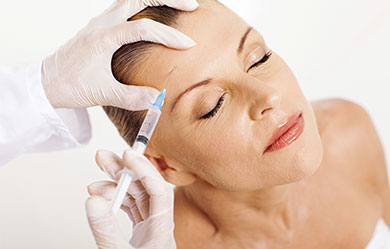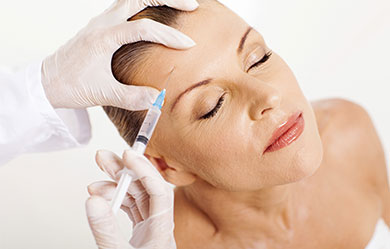
A new player officially hits the Australian anti-wrinkle injection market this week after months of trials by doctors in the form of Xeomin, a botulinum toxin type A and pronounced ‘zee-oh-min’.
It belongs to a family of medicines called ‘peripheral muscle relaxants’ and was approved in March by the Therapeutic Goods Administration (TGA) for the cosmetic treatment on adults of frown lines between the eyebrows (glabellar lines).
Xeomin is only the third botulinum toxin approved for cosmetic use in Australia since the late 1990s, the others being Botox and Dysport.
On the same day it was also approved to treat (in adults) the abnormal head position and neck pain associated with cervical dystonia, abnormal spasm of the eyelids (blepharospasm) in adults and post-stroke spasticity of the upper limbs.
Being a Schedule 4 medicine – meaning on prescription – Xeomin can only be injected by trained physicians.
According to Dr Joseph Hkeik, Sydney cosmetic physician and Medical Dean of the Australasian College of Cosmetic Surgery (ACCS), Australians are now spending up to $1 billion each year on aesthetic medicine, ‘exceeding their American counterparts by almost 40 per cent per capita*.’
In keeping with this trend, more and more spas and clinics are moving into the medi-space, aligning with doctors or nurses to provide anti-wrinkle and dermal filler injections for their clients along with an array of other aesthetic treatments.
To this end, it’s important for aesthetics business owners and their teams to be aware of developments in the field, the appropriate applications of these products and the laws and strict protocols that govern their use.
The suspension in June of a nurse who was performing anti- wrinkle and dermal filler injections in a spa environment brought sharp focus on the dos and don’ts of non-medical aesthetics businesses venturing onto that turf.
In its decision on June 12, the NSW Civil and Administrative Tribunal suspended the nurse’s registration to practise, finding her ‘guilty of unsatisfactory professional conduct and serious misconduct’.
Understanding these products and the dos and don’ts can not only protect a business’s reputation but its very survival!
WHAT IT IS
‘Xeomin is a purified neurotoxin cosmetic injectable, free of complexing proteins,’ says Dr Hkiek. ‘The presence of these inactive components [complexing proteins] is not required for it to work.
‘An innovative manufacturing and purification process was used to separate the complexing proteins from the purified neurotoxin.’
Xeomin blocks the transmission of signals from nerves to the muscles, by hindering the production of neurotransmitters (signal-relaying chemicals), allowing the muscles to temporarily relax.
Xeomin was originally introduced in Germany in 2005 for the treatment of movement dysfunctions. Australia is the 20th country to adopt its use and is distributed here by Merz Aesthetics.
WHAT IT CAN DO
At the Xeomin media briefing in June, Sydney cosmetic physician Dr Van Park said many studies have shown that the perceived qualities of ‘approachability and friendliness’ can make people seem more attractive than their actual physical appearance might otherwise indicate.
‘Deep wrinkles and skin folds can create an angry, upset or sad appearance and these negative expressions can lead to disadvantages and discrimination both socially and in the workplace,’ she said.
And an ‘angry frown’ was a key factor in creating these perceptions, even if a frowner was actually very amiable and in a good mood.
Dr Hkiek added that taking too much expression out of a person’s face with anti-wrinkle injections could run counter to a client’s interests but treating the glabellar region could make profound improvements to the appearance.
‘However happy and friendly a person might actually be, frown lines between the eyebrows can create an impression of unhappiness, tiredness, anger or outright hostility, among other unattractive qualities, and certainly make a person look older than they are,’ he said.
‘Anti-wrinkle injections in Australia are actually only officially indicated for use on the glabellar, even though they are now widely used to relax lines and wrinkles on other areas of the face and re-contour features with strategic injections [for instance, lifting the brows for a younger, brighter-eyed or reversing drooping, `sad sack’ mouth corners].
‘I am not an advocate of freezing the whole forehead, which leaves a client’s face unable to express emotion, but certainly softening glabellar lines will make a profound difference to their perceived age and attractiveness.’
Dr Park further said that ‘the aim of cosmetic enhancement should be to help people look the best possible versions of themselves.
‘This is an art form and depends on the practitioner’s understanding of what is right for that individual and the individual’s understanding of what is right for them. It is an important partnership.
‘The irony is that somebody who has too many rejuvenation treatments won’t actually end up looking better, or younger. Just different. What is the point of that?
‘Having said this, the vast majority of my clients ask to look `refreshed’ and `less tired’ as opposed to saying things like `make me beautiful’ or `I want to look 10 or 20 years younger’
‘With advances in medicine and nutrition4 leading to an ageing population and with the Government’s proposition to raise the retirement age to 70 years, we anticipate an increase in demand for cosmetic injectables as the pressure builds to remain viable in the workplace.’
DOS AND DON’TS
As exciting as it is to be able to offer these services to your customers, you can’t shout them from the rooftop.
This is an area where many businesses can be caught out. It is simply illegal to advertise Schedule 4 medications by brand name. You may only use acceptable descriptions set out by the Code of Practice such as ‘anti wrinkle injections’ or ‘dermal fillers’.
Spas and clinics, as with medi-clinics, need to observe the Code of Practice provisions for advertising that includes truth and accuracy in advertising.
There are particular provisions and requirements for before and after photographs. For example, photos cannot be airbrushed or altered. They must have an accurate caption describing all the treatments involved in the photo. It is also not permitted to offer time-limited discounts or to engage in competitions with medical procedures as prizes.
The Cosmetic Physicians Society of Australasia (CPSA) has put this ready-reference guide together for those who may be considering taking the leap into the injectables arena:
- Schedule 4 medicines (anti-wrinkle and dermal fillers) must be prescribed by a qualified doctor. However, a doctor may delegate the administration of these injections to a registered nurse, provided that certain procedures are adhered to.
- There are other strict requirements associated with the use of Schedule 4 medicines, such as an accurate record of stock removed from the doctor’s rooms, records of injection and reconciliation of stock. The CPSA recommends those prescribing such medicines are familiar with relevant state legislation and the TGA Act.
- The prescribing doctor must be currently registered and qualified. He or she must consult with the patient. This includes preparing a treatment plan.
- In the case where the doctor delegates to a nurse to administer the treatment, the prescribing doctor needs to provide written instructions or orders and supervise the treatment administered by the registered nurse.
- The registered nurse involved in the treatment needs to have current registration, adequate training in the procedure and the prescribing doctor needs to be satisfied with his/her qualifications. Registered nurses cannot supervise or delegate to other nurses (the administration of S4 medicines).
- The nurse’s indemnity insurance should cover such cosmetic treatments.




